
views
Horticulturist Lauren Kurtz writes: "The Peace Lily loves its shade! Curled and pale leaves can indicate too much light and dried and browning leaves can be damaged from direct sunlight. Place this plant in low to moderate light conditions and never in the direct sun."
Maintaining a Peace Lily

Choose a spot for your peace lily. Peace lilies are native to hot, moist, shady tropical rainforests. Thus, in most temperate climates, they cannot be left outside year-round. However, inside, where it is usually relatively warm and humid compared to the outside environment, the plant can do well. The peace lily should be close to, but not directly under a window in a warm room in your house where it will benefit from indirect sunlight. North or West facing windows are best as these do not allow direct sunlight all day. Try to avoid exposing your plant to cold air or too much sun, as these can cause the plant to become unhealthy and develop brown, shriveled leaves. Tip: Depending on your climate, you may be able to leave your peace lily outdoors for part of the year on a shady patio or similar location when the weather is warm and humid. If you happen to live in a tropical location, however, you can safely leave your plant outside year-round.
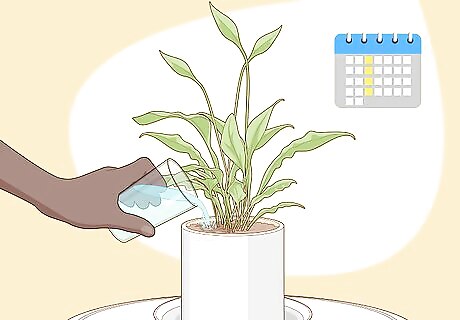
Water the peace lily adequately. The best care you can give your peace lily is to water it attentively. When (and only when) the potted soil is dry, add enough water to make it damp, but not so much as to create standing water. Too little water will cause the plant to wilt and die - in fact, if you neglect to water your plant, you should be able to see it visibly droop. However, too much water can cause a condition called root rot which can be fatal to the plant. Aim to water about once per week, when the soil is dry. It is sometimes recommended to even wait until the plant has begun to wilt ever-so-slightly before each watering.
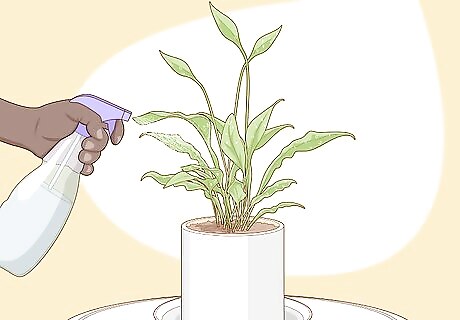
Mist the leaves several times a week with a spray bottle. Peace lilies thrive in the high humidity levels of the tropics, so, in addition to watering the soil, regularly mist your lily with a spray bottle to replicate the humid air of the rainforest. Mist your plant more frequently in the summer growing season - the more water you can supply the blooms, the healthier it will be. This plant is sensitive to chlorine, so use dechlorinated water. You can dechlorinate tap water by leaving it out at room temperature for 24 hours.
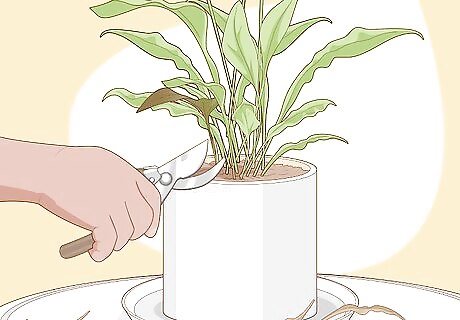
Trim any unhealthy leaves from your plant. Compared to certain other plants, peace lilies don't need to be pruned very frequently. However, if, for whatever reason, one or more of your lily's limbs or leaves become brown or wilted, you may want to prune the leaves to keep the plant from wasting energy on the dying appendage. Use cleaned, sharp scissors/pruning shears to remove any unhealthy or dead spots - make your cuts cleanly and near the soil level without damaging healthy tissue. Wilting and brown leaves can simply be an indication that you forgot to water your plant, but they can also be a symptom of a more serious problem. If you find yourself frequently needing to prune even when caring for your lily properly, look for signs of a more serious problem (see "Solving Peace Lily Maladies" below) and seek to cure the root cause.

If you fertilize, do so cautiously. Apart from water and indirect sunlight, your plant will not need much maintenance. Fertilizers and nutrient supplements should not be necessary to grow a healthy, thriving peace lily. However, if you desire to do so (for instance, because you want to grow exceptionally large, vibrant blooms), take care so as not to over-fertilize, as peace lilies can be somewhat sensitive plants. Use a standard 20-20-20 house plant fertilizer at one half or one quarter its recommended strength about once per month in the spring and summer, when the plant's growth is most active. Green blooms are a sign of over-fertilization. If your plant exhibits this symptom, stop fertilizing and cut your fertilizer dose in half the next growth season.
Re-potting a Peace Lily
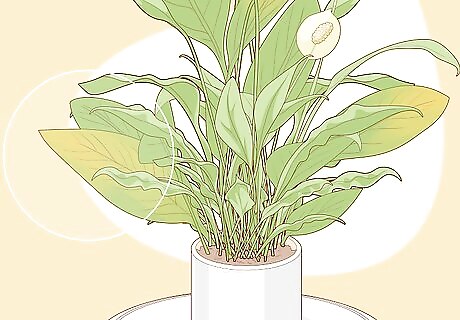
Recognize the signs that signify that re-potting is necessary. Like nearly all potted plants, if allowed to grow, peace lilies will eventually become too big to comfortably thrive in their original container. When your peace lily becomes too large for its pot, you may notice that it seems to require increasingly frequent watering and/or that its leaves turn yellow for no apparent reason. You may also be able to see its roots crowd the surface of the soil. Generally, peace lilies should be re-potted every 1-2 years, so if it's been about this length of time and you notice some of the above symptoms, your plant is a likely candidate for re-potting.

Use a pot of suitable size. When you re-pot a peace lily, you'll obviously want to use a bigger pot than you were using previously so that your plant has additional room to spread its roots and grow. Use a pot about 2 inches (5.1 cm) wider in diameter than the previous pot - a relatively small increase in pot size can give a plant enough room to grow for several years. Generally, peace lily's won't ever require pots larger than about 10 inches (25.4 cm) in diameter, so if your pot is larger than this and the lily is still exhibiting troubling symptoms, there may be another issue. Almost any pot material is fine - ceramic, plastic, and clay all work well. Make sure your pot has one or more drainage holes on the bottom. It's essential that water be able to drain from the pot - if not, your lily may become at risk for root rot.
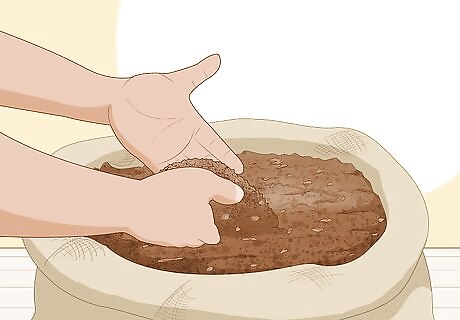
Use an appropriate potting mix. As has been alluded to above, peace lilies are native to tropical rainforests. They typically grow under a thick, multi-tiered forest canopy and thus are nearly constantly surrounded by decaying plant matter. When picking a potting soil, choose one that retains this quality. Use a peat-based potting soil that contains composted bark, along with sand or perlite. Ideally, your soil should be light and springy (to allow proper drainage) and have little to no odor.
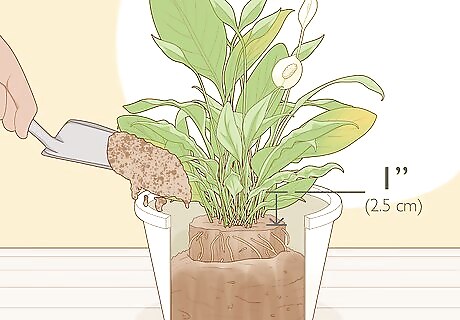
Transfer your plant to its new container. Prepare your new pot by filling it with enough compacted soil so that your plant sits comfortably on top of it. Ideally, you should only need to add dirt around the sides of the plant, rather than below it or on top of it. Gently pack your soil down so that it will support your plant firmly without sinking downward. Pry or dig your peace lily out of its pot and place it atop the soil in its new pot. Add soil from the original pot around the plant in its new pot - using familiar soil can ease the plant's transition to its new home. Water your plant and add more soil when the water makes the soil in the pot settle. When the transition is complete, the soil in the new pot should be at a level of about 1/2" to 1" (1.3 to 2.5 cm) below the rim of the pot. Tip: If you're having difficulty removing your plant from its old pot without breaking or tearing it, water it generously and let it soak for an hour.
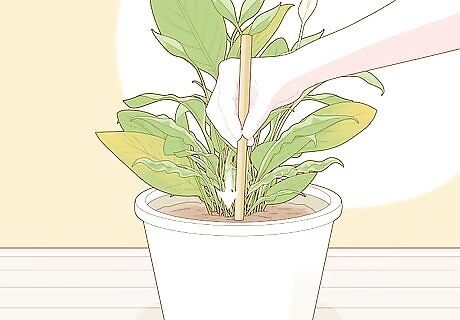
Be prepared to use a stake to support the new plant. After it is re-potted, your plant's roots won't immediately have a strong hold on its new soil. This can make it difficult to get your plant to stay upright. If you're having a difficult time balancing your plant, use a sturdy wooden stake or dowel to hold the peace lily's stalk up. Bury the stake in the potting soil (taking care not to damage the plant's roots) and use a wire to tie the stalk to the stake. Remove the stake when the plant has established its roots and is able to stand on its own.
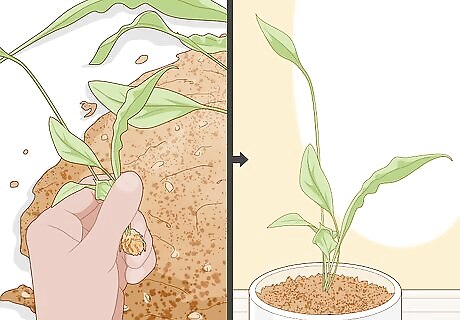
To create two separate plants, pot a "crown" from the old plant. If, rather than moving your plant to a new pot, you'd like to instead grow an entirely new plant in another pot, remove one of the plant's crowns and pot this in the new pot instead of the entire lily. A peace lily's "crowns" are clusters of two or more leaves that are separate and distinct from the main part of the plant. To separate a crown from your main lily, first, remove the entire plant, crowns and all, from its pot. Work from the top of the crown down to the roots, disentangling the roots of the crown from the roots from the main plant. This can take some time and lead to accidental root breakages - this is common, but try to avoid breaking more roots than necessary. When you've completely separated the crown from the main plant, plant it in its own small pot (no bigger than about 6 inches in diameter) as you would do with a normal peace lily.
Solving Peace Lily Maladies
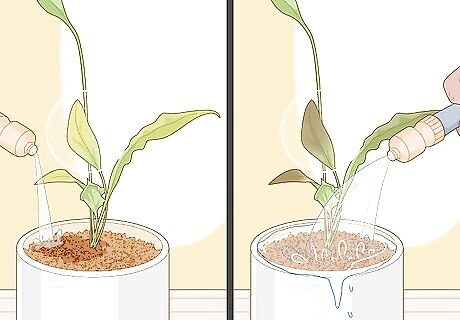
Recognize the signs of under-watering and over-watering. One of the most common sources of problems when growing peace lilies is an improper watering regimen. Under-watering and over-watering can cause a variety of non-specific symptoms that sometimes overlap with other peace lily ailments. However, since improper watering is also one of the easiest problems to fix, try attempting these remedies first before moving on to a more drastic solution. Under-watering should be fairly obvious: dry soil accompanied with wilting, yellowing leaves and a drooping stalk is a dead giveaway. Fix this by watering and misting more regularly - at least once a week for each. Note that plants that outgrow their containers will have a difficult time absorbing the water they need from a typical watering session. Over-watering can be slightly harder to diagnose but is often characterized by brown leaf tips. Note that over-watering can lead to root rot, a separate, much more serious condition.
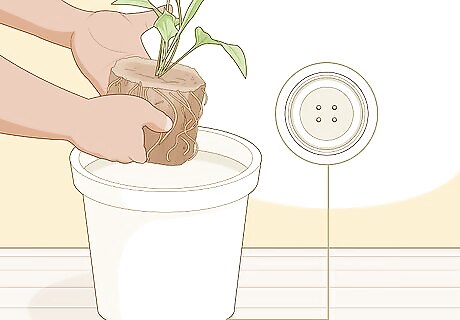
Repot a plant with root rot. Root rot is a serious condition that can affect any potted plant with roots below the surface and can easily kill the plant. Generally, root rot is caused when a plant suffers from over-watering or poor drainage. If the roots are held in contact with standing water for a prolonged period of time, it becomes difficult for them to get the air that they need to function correctly, and as a result, they will literally begin to rot. Certain types of microorganisms called water molds contribute to the spreading rot, the spores of which can spread root rot to another plant if adequate moisture is present. Root rot is often fatal, but, to attempt to remedy it, immediately remove your lily from its pot and cut off any dead, slimy, or otherwise rotten portions of root. Pot the plant in a new pot with dry soil and proper drainage. Note: Alternatively, as a solution, you may opt to re-pot a lily's crown to another container if its roots are unaffected by rot. The original plant may die, but the second will be a genetic copy of the first. Though root rot infects the plant below the surface, it will cause the plant to visibly begin to die above ground. If your lily seems to become increasingly wilted even with proper sun and frequent watering, root rot is likely the culprit.
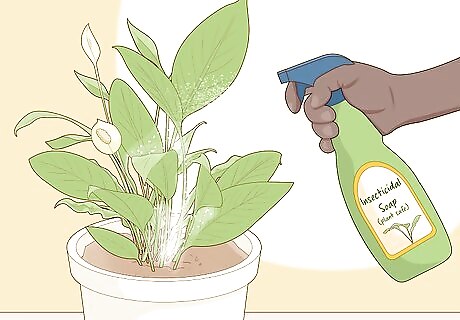
Use insecticidal soap to remove pests like aphids or mites. Peace lilies are sometimes susceptible to infection by aphids, mites, or other small arthropods. If you notice your lily's leaves begin to wilt or die, especially if accompanied by visible pests, a sticky, slimy discharge, or the presence of white webbing, it's likely that your plant has a pest infestation. Use a strong stream of water to blast the pests off of the plant, then, to make sure they don't return, use a plant-safe insecticide or this homemade recipe for insecticidal soap: Combine 1 Tbsp. (15 ml) vegetable oil, 3 Tbsp (16 g) cayenne pepper, and 1 Tbsp. (12 g) natural fat-derived soap (not liquid dish soap) in 1 quart (.95 liters) of warm water. Use a spray bottle to give your plant a thorough coating, but not before testing on a small part of the plant and leaving the soap in place for a day to ensure it doesn't cause any damage.
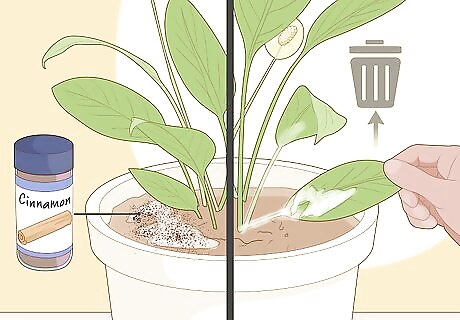
Clean or dispose of a fungus-infected plant. Fungus infections can range from harmless to potentially fatal. If you see a white or grey fuzzy growth on the surface of the soil, you don't need to be terribly concerned, as this fungus is not a danger to the plant (though it can irritate some humans, especially those susceptible to allergies). To clear this minor fungal growth, you may want to try sprinkling cinnamon (which has anti-fungal properties) on the fungus. However, if the lily itself develops a dark or black coating on its stalk or leaves for no other apparent reason (frost damage, etc.), your plant likely has a serious fungal infection. Discarding the entire plant is always a viable option in this case, as fungal spores can be very persistent, remaining in the soil and surrounding area for a significant amount of time, where they can re-infect other plants. However, if you'd like to try to save the plant, carefully remove all the affected areas of the plant and discard them somewhere that they'll pose no danger. (like your garbage). Next, water the plant with compost tea, a natural fungicide, to attempt to kill spores that remain in the soil.


















Comments
0 comment